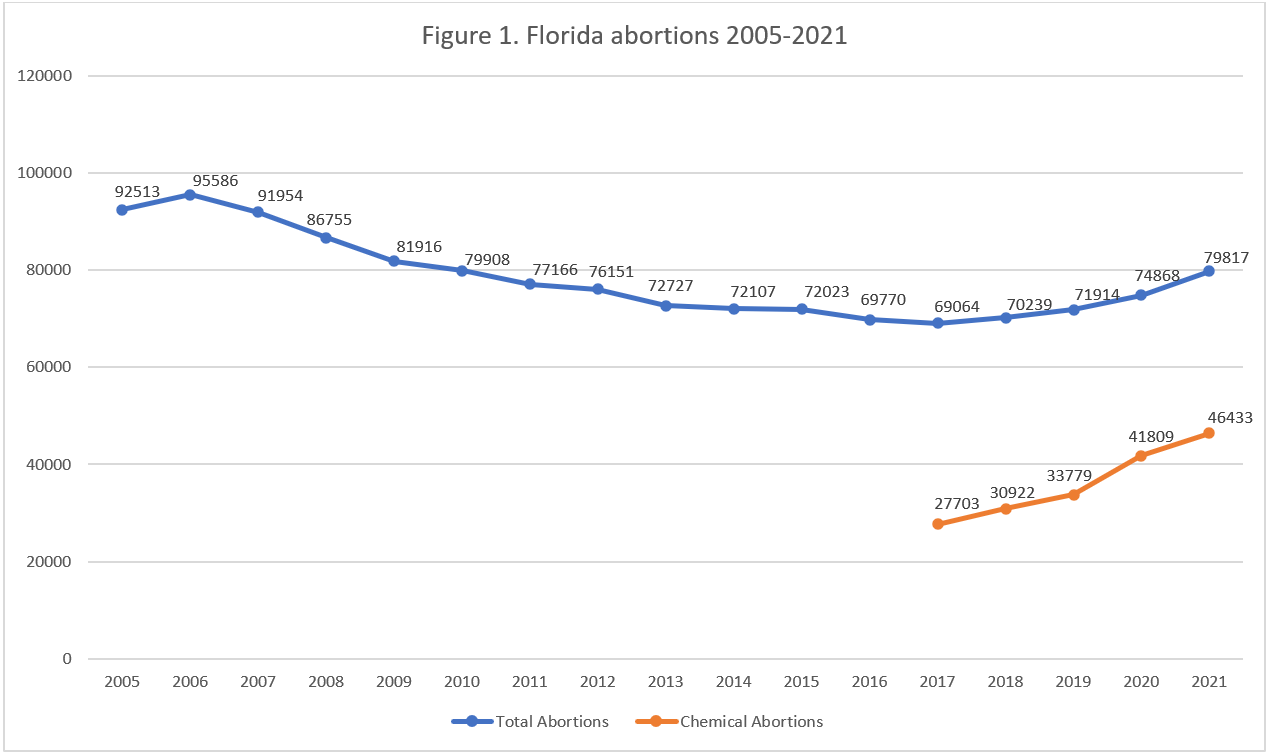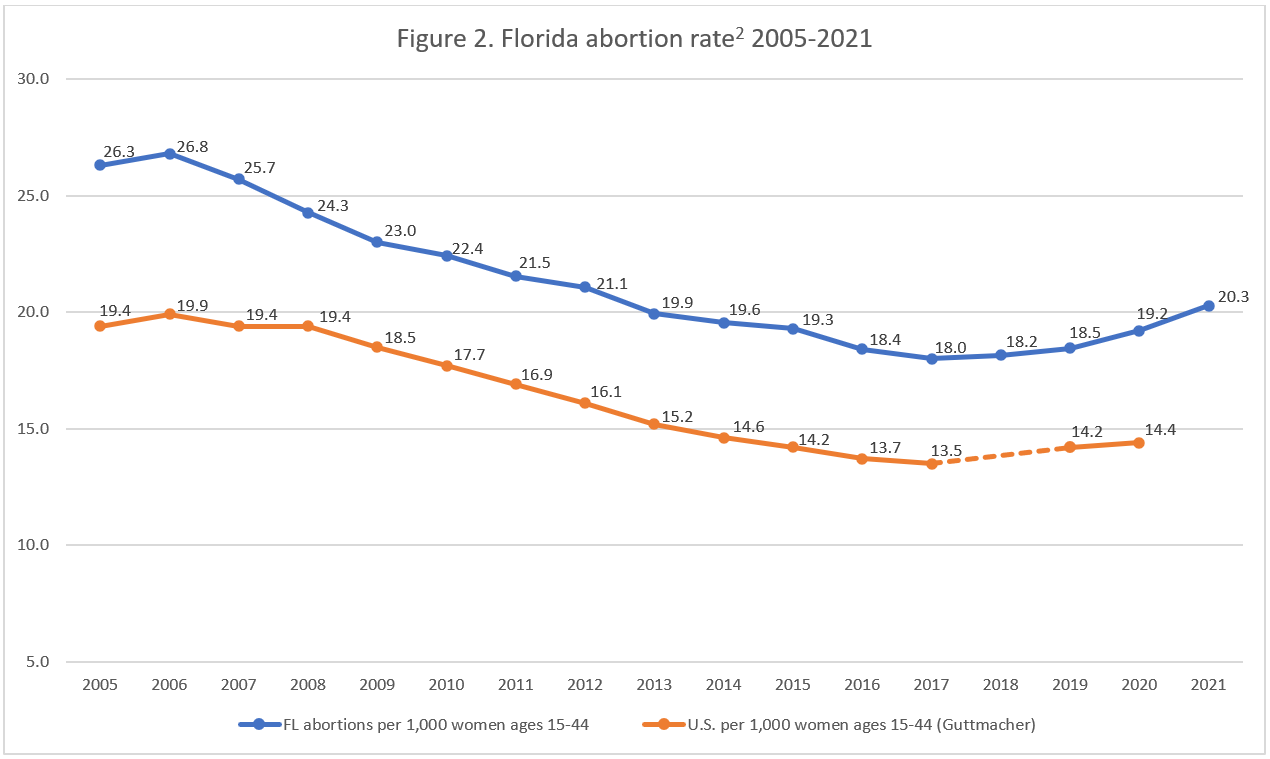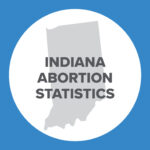Abortion Reporting: Florida (2021)
Note: For this CLI summary, the usage of “gestation” reflects Florida’s definition of gestation in 2021, which is synonymous with post-fertilization age and is different than the definition that is commonly used based on a woman’s reproductive cycle.
Florida publishes preliminary abortion totals on the website of its Agency for Health Care Administration (AHCA). Its full report was provided to the Charlotte Lozier Institute (CLI) upon request in August 2022. This is the 13th state summary to be posted by CLI for 2021 abortion statistics.
Statistics and Changes in Florida Abortions, 2020-2021

This report does not include information on Planned Parenthood’s Florida abortion market share.
Abortion Totals and Trends
Nearly 80,000 abortions were reported in Florida in 2021, an increase of seven percent from the previous year. Of the 79,817 abortions performed in 2021, there were 46,433 chemical abortions, 58 percent of the total. Chemical abortions increased by 11 percent from 2020 (Fig. 1).
The Charlotte Lozier Institute (CLI) estimates that Florida’s 2021 abortion rate was 20.3 abortions per 1,000 women ages 15 to 44, up six percent from 2020 (Fig. 2). Florida’s abortion rate remains well above the national rate. As of November 2022, 24 states had released 2021 abortion statistics, and 17 states reported increases from 2020.
Florida publishes regular preliminary abortion reports on the AHCA website and makes its full report available upon request. Reports are finalized in July, and numbers can change slightly. The report AHCA provided to CLI matches the latest report on AHCA’s website.
CLI estimates that 2,286 abortions 13 weeks post-fertilization or later (approximately 15 weeks of gestation or later) were performed in Florida in 2021, based on data from ACHA.
State Report Summary
Ninety-four percent of Florida abortions were reported to be performed on state residents in 2021, while six percent were performed on nonresidents, including 2.3 percent on women from Georgia and 1.7 percent on Alabama residents. Seven percent of the abortions were performed on girls under the age of 20. Twenty-seven percent of Florida abortions were obtained by women ages 20 to 24, and 28 percent were on women ages 25 to 29. Just over a third of abortions (34 percent) occurring in Florida were performed on women in their thirties, and four percent were on women ages 40 and older.
Forty-nine percent of the abortions were performed on white women, and 38 percent were on black women. CLI estimates that Florida’s black abortion rate was 37.4 abortions per 1,000 women of childbearing age, nearly three times the white rate of 13.7. Nine percent were performed on women of other races, and five percent were on women of unknown race. Twenty-seven percent of Florida abortions were on Hispanic women, 67 percent on non-Hispanic women, and five percent on women of unreported ethnicity.
Twelve percent of the abortions were on married women, and 75 percent were on unmarried women, while 13 percent were obtained by women whose marital status was not reported. Thirty-eight percent of abortions were on women with no previous live births. A quarter were on women with one live birth, and 36 percent were obtained by women with two or more live births. Over half the women undergoing abortions (55 percent) reported zero prior abortions, while just over a quarter (26 percent) reported one abortion and 19 percent had undergone more than one previous abortion.
More than half the abortions reported in Florida in 2021, 58 percent, were chemical. Thirty-eight percent were curettage procedures, and a different or unreported method was used for four percent. Eight abortions were performed via hysterotomy or hysterectomy.
Just under three-quarters of the abortions (74 percent) occurring in Florida were performed at six weeks post-fertilization or earlier.1 Fourteen percent were performed between seven and eight weeks, and six percent occurred between nine and 10 weeks after fertilization. Three percent were performed between 11 and 12 weeks, two percent between 13 and 14 weeks, and one percent between 15 and 17 weeks. There were 1,050 abortions (1.3 percent) performed at 18 weeks post-fertilization or later (approximately 20 weeks of gestation or later). Overall, abortions at 18 weeks post-fertilization or later increased by 14 percent from 2020 and 23 percent from 2017.
Florida’s report uses the term “gestation” to refer to post-fertilization age, even though gestational age typically dates pregnancy from two weeks prior to fertilization, because Florida law defined “gestation” to be equivalent to post-fertilization age. In 2022, Florida amended its statute to define gestation as dating pregnancy from the woman’s last menstrual period, which is how the term is typically used. For this CLI summary, the usage of “gestation” reflects Florida’s definition of gestation in 2021, which is synonymous with post-fertilization age.
Seventy-four percent of Florida abortions were reported as “elective,” 21 percent were performed for social or economic reasons, and two percent were performed for the mother’s emotional or psychological health. In contrast, one percent were performed for the mother’s physical health and just under one percent (0.9 percent) were performed because the unborn baby had an abnormality. There were 118 abortions (0.1 percent) performed because of risk to the mother’s life, another 118 abortions (0.1 percent) due to rape, and eight abortions due to incest.
There were four babies who were reported to have been born alive during abortions in Florida in 2021. The report does not indicate what happened to the babies after they were born.
Legislative Changes
On April 14th, 2022, Florida Governor Ron DeSantis (R) signed into law CS/HB5 to limit abortion after 15 weeks gestation, when the unborn baby can feel pain. The law has exceptions for serious medical emergencies, to prevent serious injuries to the mother, and for fetal anomalies. The law also changed the reporting definition of gestation to be more accurate, since the original statute defined “gestation” to be synonymous with post-fertilization calculations. The 2022 abortion report will be the state’s first report that should reflect these definitional changes. The law went into effect in July 2022 and was blocked from enforcement shortly after. However, the temporary injunction was removed, and the law went back into effect. The law’s state constitutionality is now being decided by the Florida Supreme Court.
State Ranking
In CLI’s 2016 survey of abortion reporting across the country, Florida was ranked at 40th best. Starting in 2017, Florida made significant improvements to its abortion reporting, now including the type of abortion procedures used and the demographics of women who obtain abortions in the state. As CLI has previously suggested, Florida could continue to improve its reporting by making all tables available online and providing more information about the babies who survive abortions in the state. Florida could also report reasons why late-term abortions were performed and whether any women experienced complications from abortion.


- For more information on Florida’s pre-HB5 method of measuring the length of pregnancies ending in abortion (the method used to calculate the statistics provided to CLI for 2021), please see here: https://lozierinstitute.org/abortion-reporting-florida-2019/
- Rates were calculated by CLI using the following formula: (total number of abortions performed in Florida ÷ number of resident women ages 15-44) x 1,000. Rates may differ slightly from previous CLI articles due to revised population estimates. Population estimates were obtained from the CDC WONDER database. Estimates for 2005-2009 are intercensal estimates of the July 1 resident population. Estimates for 2010-2019 are Vintage 2020 postcensal estimates of the July 1 resident population. Estimates for 2020-2021 are Vintage 2021 postcensal estimates of the July 1 resident population. Estimates were produced by the U.S. Census Bureau and the National Center for Health Statistics.
























